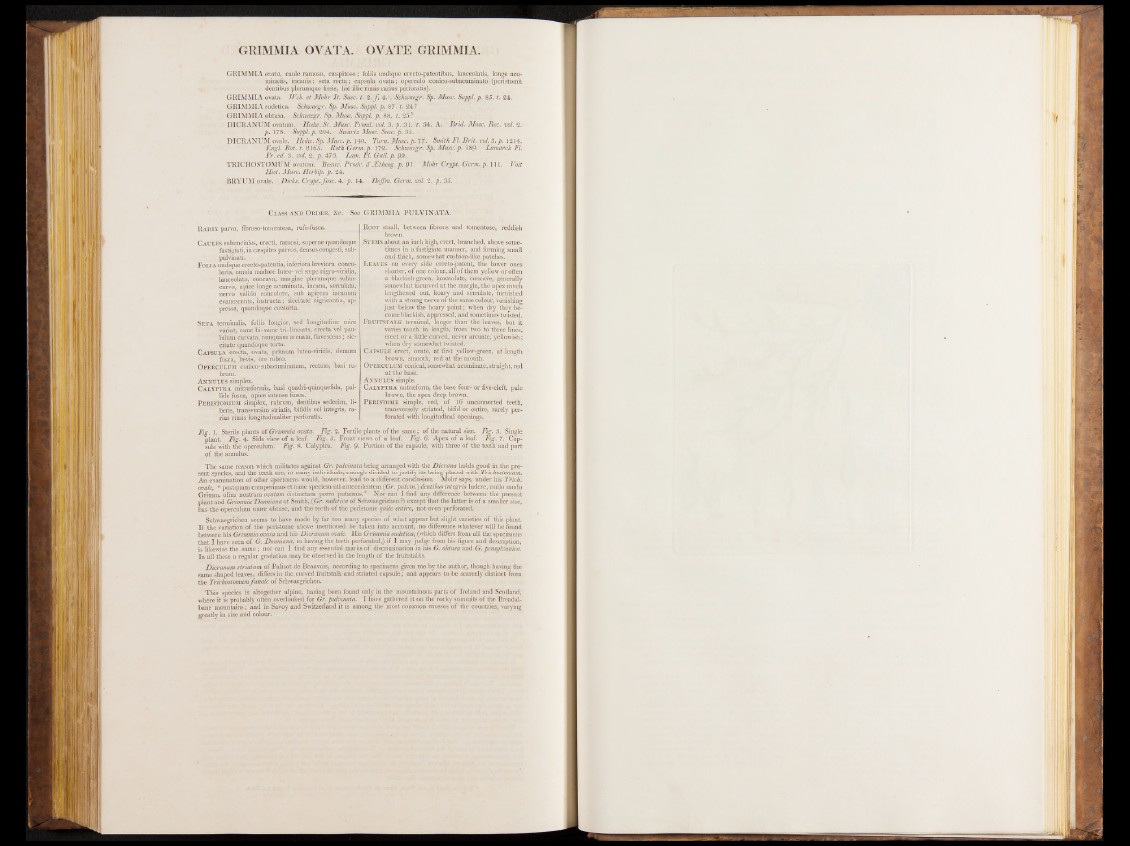
GRIMMIA OYATA. OVATE GRIMMIA.
G RIMMIA ovata, caule ramoso, cæspitoso ; foliis undique erecto-patentibus, lanceolatis, longe acu-
minatis, incanis’: seta recta; capsula ovata; operculo conico-subacuminato. .(peristomii
dentibus plerumque fissis, hie illic rimis rarius perforatis).
GRIM M IA ovata. Web. et Mohr I t . Suec. t. 2.ƒ . 4.N Schwaegr. Sp. Musc. Suppl, p . 85. t. 24.
GRIM M IA sudetica. Schwaegr. Sp. Musc. Suppl, p. 87. t. 24?
GRIM M IA obtusa. Schwaegr. Sp. Musc. Suppl, p. 88. t. 25 ?
D IC RA N UM ovatum. Hedw.St. Muse. Frond, ml. Si p. 31. t. 34. A.. JBrid. Muse. Rec. ml. 2.
p . 178. Suppl, p. 204. Swartz Muse. Suec. p . 35.
DICRA N UM ovale. Hedw. Sp. Muse. p. 140. Turn. Muse. p. 77. Smith FI. B r it. ml. 3. p. 1214.
Engl. Bot. t. 2165. Roth Gei'm.p. 172. Schwaegr. Sp. Muse. p. 189. Lamarck Fl.
F r. ed. 3. vat. 2. p. 473. Lam. Fl. Gall. p. 99-
TRICHOSTOMUM ovatum. Beauv. Prodr. d'Æiheog. p . 91. Mohr Crypt. Germ.p. 111. Voit
Hist. MusC’. Het'bip. p. 24.
BRYUM ovale. Dicks. Crypt, fa sc . 4. p. 14. Hoffm. Germ. ml. 2. p. 35.
Class a n d Order, &c. See G RIMMIA PULVINATA.
Radix parva, fibroso-tomentosa, rufo-fusca.
Caules subunciales, erecti, ramosi, supeme quandoque
fastigiati, in cajspites parvos, densos congesti, sub-
pulvinati.
Folia undique erecto-patentia, inferiorabreviora. coneo-
loria, omnia madore luteo- vel stepe nigro-viridia,
lanceolata, concava, margine plerumque subin-
curvo, apice longe acuminata, incana, serrulata,
nervo valido concolore, sub apicem iqcanum
evanescent«, instructa ; siccitate nigricantia/ap-
pressa, quandoque contorta.
Seta terminalis, foliis longior, sed longitudine mire
variat, nunc bi- nunc, tri- linearis, erecta vel pau-
lulum curvata, nunquam arcuata, flavescens; siccitate
quandoque torta.
Capsula erecta, ovata, primum luteo-viridis, demum
fusca, las vis, ore rubro.
Operculum conico-subacuminatum, rectum, basi ru-
brum.
Annulus simplex.
CALYPTRA mitrasformis, basi quadri-quinquefida, pal-
lide fusca, apice intense fusca.
Peristomium simplex, rubrum, dentibus sedecim, li-
beris, transversim striatis, bifidis vel integris, rarius
rimis longitudinaliter perforatis.
Root small, between fibrous and tomentose, reddish
brown.
Stems about an inch high, erect, branched, above sometimes
in a fastigiate manner, and forming small
and thick, somewhat cushion-like patches.
Leaves on every side erecto-patent, the lower ones
shorter, of one colour, all of them yellow or often
a blackish green, lanceolate, concave, generally
somewhat incurved at the margin, the apex much
lengthened out, hoary and serrulate, furnished
with a strong nerve of the same colour, vanishing
just below the hoary point; when dry they become
blackish, appressed, and sometimes twisted.
Fruitstalk terminal, longer than the leaves, but i.t
varies much . in length, from two to three lines,
erect, or a little curved, never arcuate,' yellowish;
when dry somewhat twisted.
Capsule erect, ovate, at first yellow-green, at length
brown, smooth, red at the mouth.
Operculum conical, somewhat acuminate, straight, red
at the base.
Annulus simple.
Calyptra mitrasform, the base four- or five-cleft, pale
brown, the apex deep brown.
Peristome simple, red, of 16 unconnected teeth,
transversely striated, bifid or entire, rarely perforated
with longitudinal openings.
Fig. 1. Sterile plants of Grimmia ovata. Fig. 2. Fertile plants of the same ; of the natural size. Fig. S. Single
p la n t Fig. 4. Side view of a leaf. Fig. 5. Front views of a leaf. Fig. 6. Apex of a leaf. Fig. 7. Capsule
with the operculum. Fig. 8. Calyptra. Fig. 9'. Portion of the capsule, with three of the teeth and part
of the annulus.
The same reason which militates against Gr. pulvinata being arranged with the Dicrana holds good in the present
species, and the teeth are, in many individuals* enough divided to justify its being placed with Trichostomum.
An examination of other specimens would, however, lead to a different conclusion. Mohr says, under his Trich.
ovale, “ postquam comperimus et banc speciera uti antecedentem (Gr. pulvin.) dentibus integris ludere, nullo modo
Grimm. Olim nostram ovatam distinctam porro putamus.” No r can I find any difference between thé present
plant and Grimmia Donniana of Smith, {Gr. sudetica of Schwaegrichen ?) except that the latter is of a smaller size,
has the operculum more obtuse, and the teeth of the peristome quite entire, not even perforated.
Schwaegrichen seems to have made by far too many species of what appear but slight varieties of this plant.
I f the variation o f the peristome above mentioned be taken into account, no difference whatever will be found
between his Grimmia ovata and his Dicranum ovale. His Grimmia sudetica, (which differs from all the specimens
that I have seen of G. Donniana, in having the teeth perforated,) if I may judge from his figure and description,
is likewise the same; nor can I find any essential marks o f discrimination in his G. obtusa and' G. pensylvanica.
In all these a regular gradation may be observed in the length of the fruitstalks.
Dicranum striatum of Palisot de Beauvois, according to specimens given me by the author, though having the
same shaped leaves, differs in the curved fruitstalk and striated capsule; and appears to be scarcely distinct from
the Trichostomumfunale of Schwaegrichen.
This species is altogether alpine, having been found only in the mountainous parts of Ireland and Scotland,
where it is probably often overlooked for Gr. pulvimta. I have gathered it on the rocky summits o f the Breadal-
bane mountains; and in Savoy and Switzerland it is among the most common -mosses of the countries, varying
greatly in size and colour.